West Timor
Crystal Pools and the Best Pork in the WorldWest Timor: Crystal Pools and the Best Pork in the World
I arrived in Kupang, the capital of West (Indonesian) Timor, with nothing more than a letter from the Timor Leste embassy in Bali, required to receive a visa on arrival at the border to that country, and a few tips from a West Timorese friend who lives in Australia. Oh, and with my mate Tim, who despite living in Bali for 27 years had no more clue about West Timor than I did.
We arrived at Kupang airport and took a bemo (shared minivan) to the city center. The drive was about half an hour and an interesting introduction to the island. It felt more like sub-Saharan Africa than Bali. The road was lined with shacks, some constructed from corrugated iron and some from wood and straw, and there was a reddish dust everywhere. We asked a couple of schoolgirls on the bemo how much the journey was and they told us 3k rupiah (€0.19/$0.21) each. However, when arrived near Ketapang Satu beach, where I’d seen on Maps.Me there was possibly a hostel, we gave the driver 10k (€0.64/$0.70) and he just said thank you. So we asked for our change. Twice. Which he finally reluctantly gave. Okay, so bargaining and checking prices was going to be a theme on this trip. Yes, I know we’re cheap, but it’s the principle that’s important, not the money!
We found the hostel, called Lavalon Hostel, and met its owner, a guy called Edwin, who we later found out online is quite famous amongst backpackers to Kupang. He’s an older, very smiley guy who knows the area well and helped us a lot with all our questions. There was no one else staying, but he gave us some tips on places to visit and arranged a couple of bikes for us to hire.
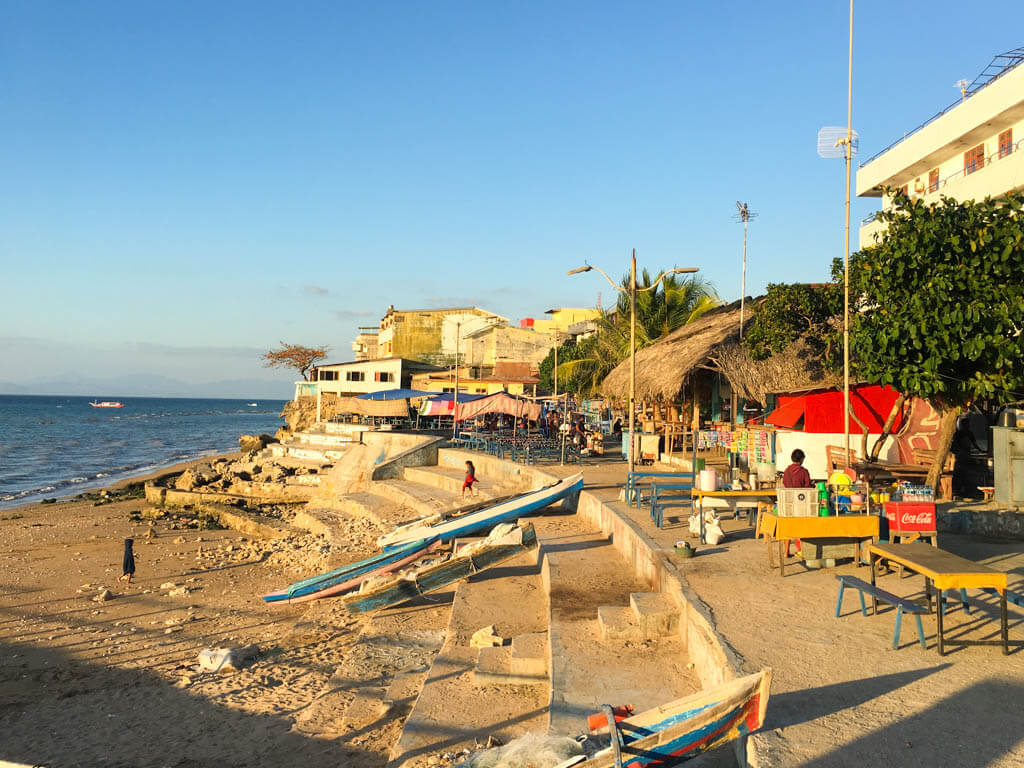
Kupang’s waterfront is a tantalising mixture of chaos and picturesque beauty
The day we arrived, we explored the streets near the waterfront, although we kept away from the water itself, as the locals had warned us about the saltwater crocodiles that live in the area. There are many small shops and restaurants and some beautiful street art covering the walls of the crumbling old waterfront buildings. We took some photos and then continued along the street until we came across a sack race!
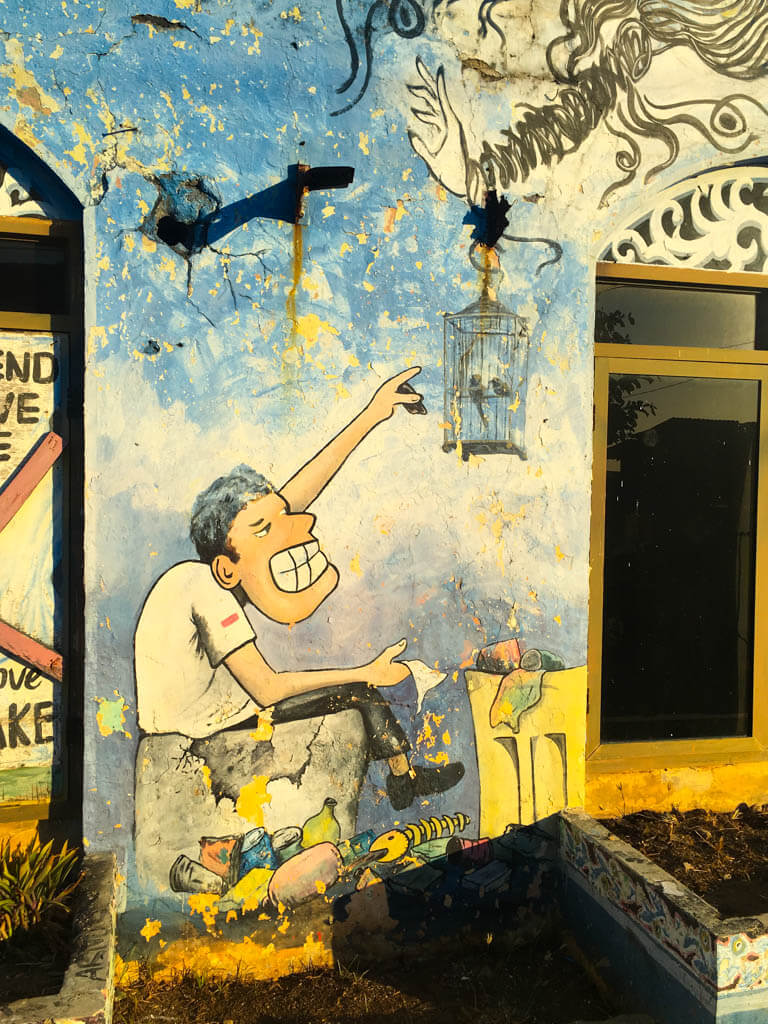
Timorese street art at its best. What an amazing way to brighten up the decaying buildings.
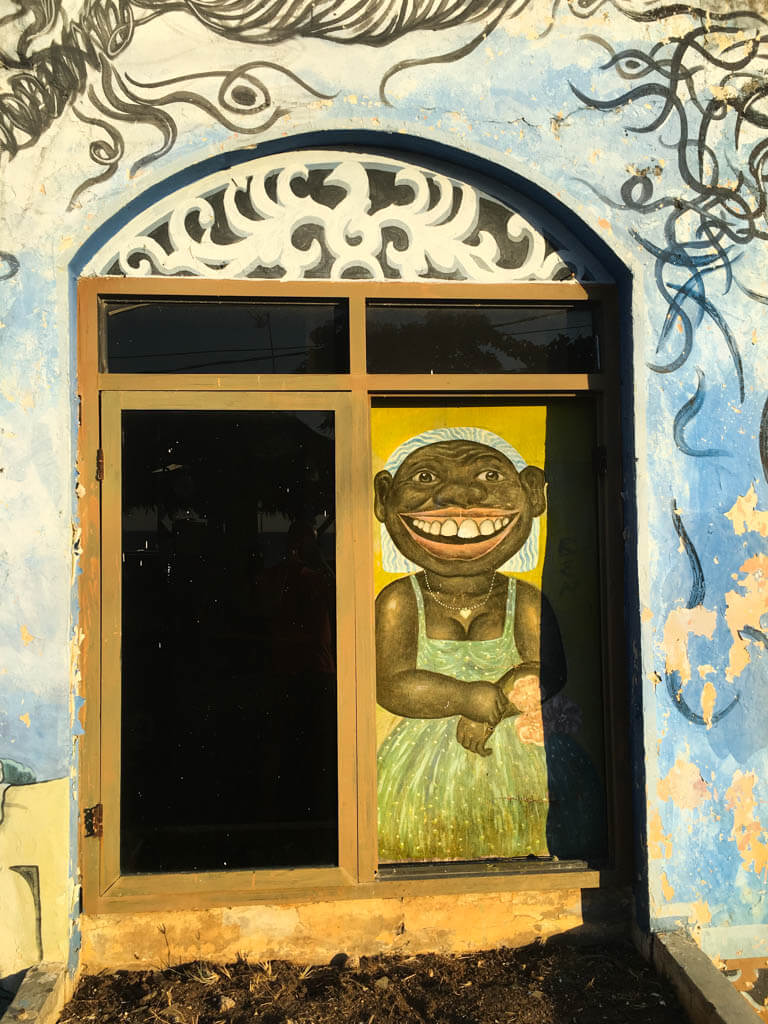
A caricature of a Timorese lady watches from the blacked out windows
Groups of young people were racing up and down as fast and they could without falling while wearing old grain sacks. It looked hilarious and the friendly locals were more than happy to welcome a couple of foreigners to watch the frivolities. I later found out that sack racing is a traditional activity around the time of Indonesian Independence day, which was in a couple of days’ time.
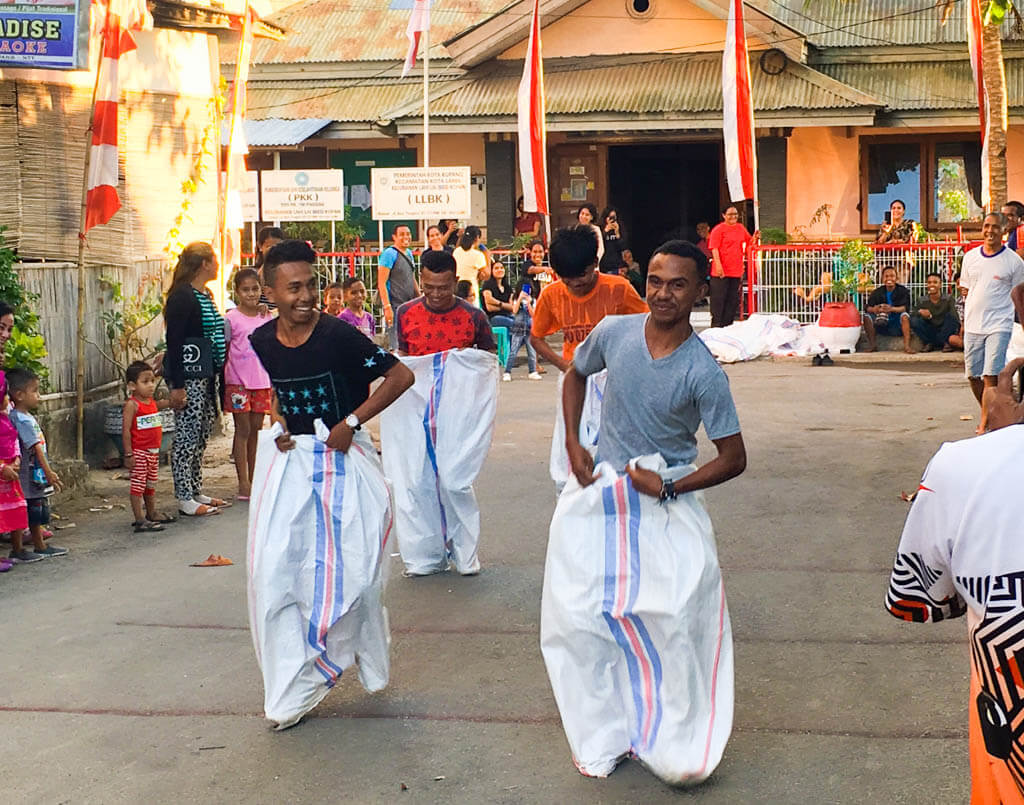
Young Timorese having a ball during an Independence Day sack race
After the races were over and the laughing subsided, we found a bar called 999 Bar and Restaurant and popped in for a beer or two. We wouldn’t leave until several hours later, once the beer or two had become fiver large Bintangs, a delicious tuna steak and plenty of flirting with the Timorese waitresses (although with extremely limited success!).
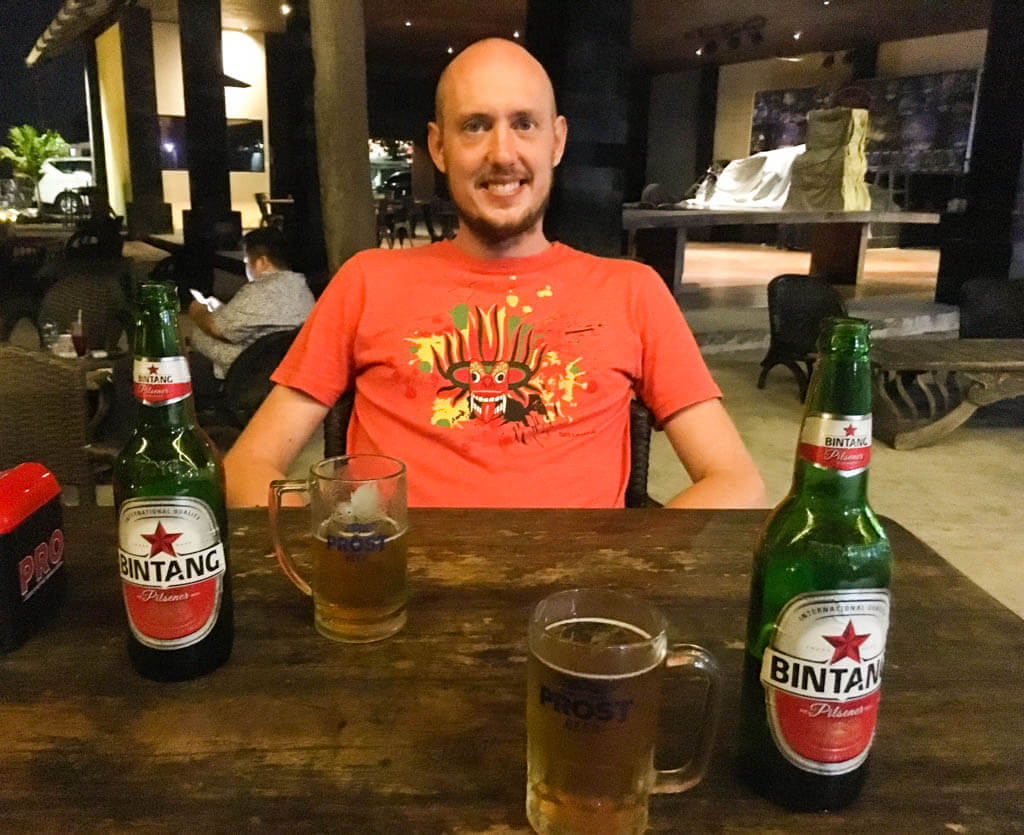
Cheers! Chilling after a hard day’s exploration of Kupang.
The Crystal Cave, Tablolong Beach and Oenesu Waterfall
Our first full day began with a mild hangover, a nice Timorese coffee and a rather dismal pancake. The pancake was tasty, but lonesome, and needed to be accompanied by several of its friends to make a decent breakfast. Oh well, you pay for what you get! After eating we headed out early on our bikes to visit the crystal cave, about 30 minutes down the coast from Kupang. We’re both quite experienced riders and the roads were not too bad by Indonesian standards, with far less traffic than Bali or Jakarta, so we soon arrived at our destination. The other thing that was really different from Bali was that we met a friendly Policeman! He even stopped the cars so that we could cross easily to take some photos by the harbour. In Bali, the first statement out of any Policeman’s mouth after seeing a foreigner is that he needs to see your license, because they know that foreigners never have international bike permits, and the second is to tell you how big a bribe he wants to let you go. It happened to me twice in ten days there, but that’s another story…
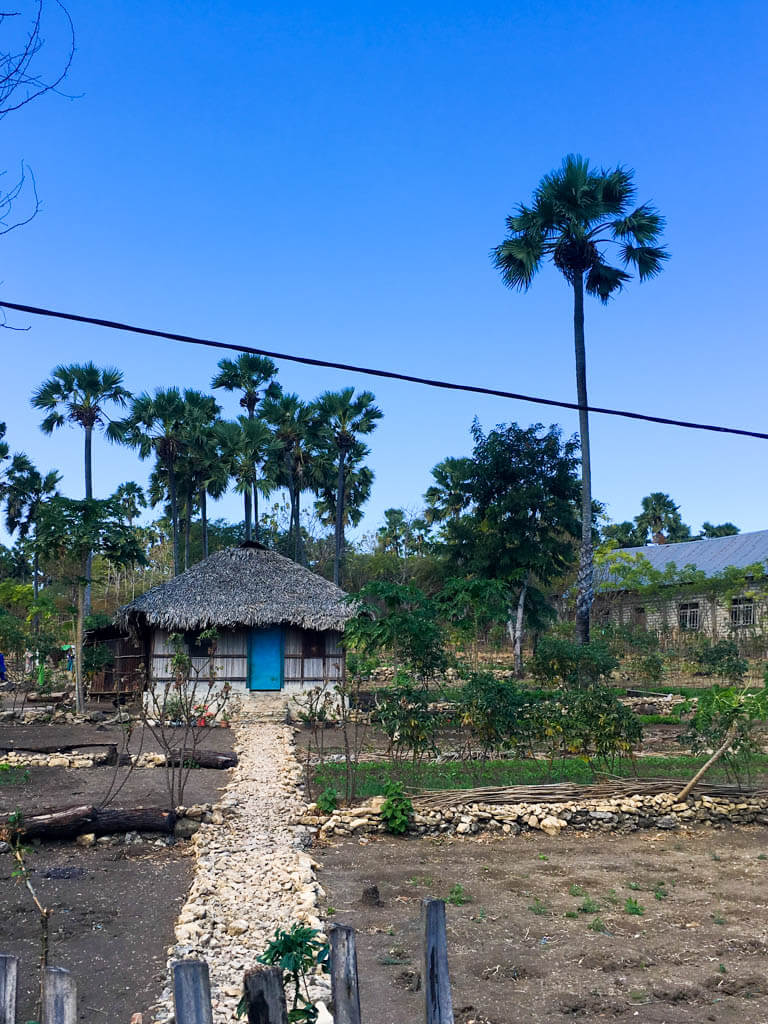
The Timorese countryside is full of little villages
It said online that the cave was open to all and that local kids often take foreigners inside, for an optional tip. That seems to have changed however, as there was a newish-looking fence around the site with a lot of barbed wire and when we arrived a man quickly appeared and asked us for 50k rupiah (€3.22/$3.52) to come inside. Tim argued that he’s an Indonesian resident, so the man told him in Indonesian that he could come in free and I should pay 20k (€1.29/$1.41), but no one actually asked me in a language I understand to pay, so I didn’t.
We entered the site and the man led us to the cave entrance. Entering, we scrambled down some rocks while the man shone a torch for us until we reached the bottom. There was the 9m deep pool from which the cave takes its name, because its water is absotutely transparent. I was scrambling across the rocks along the edge of the pool, when suddenly our guide shouted to be careful, but too late! I’d already put my foot on a rock that was submerged under half a foot (15cm) of water – it was so clear that I’d thought the rock was above the surface! And I was wearing my brand new Converses that I’d only bought the week before too.
We both changed into our swimming trunks and went for a dip. The water was cool, but not cold, and it was amazing being able to see the bottom at such a depth below. We swam around a bit, took a few photos and chatted with our guide. The place had a quiet beauty to it, illuminated softly by the narrow shafts of light shining down from the narrow cave mouth above.
Once we’d climbed back out, we both gave the man a 10k rupiah (€0.64/$0.70) tip for showing us around and he never mentioned the entrance fee again. Well, not to me! I only found out after that he’d asked Tim about it in Indonesian earlier, and Tim had told him: “He’s from Scotland, good luck getting any money out of him!”, so he never tried. Sometimes stereotypes can be useful after all.
We got back on our bikes and zigzagged our way through the little country lanes of West Timor. The scenery was mainly scrubby bush, dotted with small villages here and there, and as we rode, we frequently had to dodge goats or slow down for cows crossing the road. West Timor is one of the Christian parts of Indonesia and almost every tiny village has its own church, some of them quite pretty and surprisingly large. Statues of jesus and crosses are scattered across street corners throughout the island, even where the streets themselves are little more than dirt tracks. The roads were not too bad considering, but a few sections were pretty rough and having a bit of biking experience was definitely useful. Amazingly, even the smaller tracks are all on Google Maps, so we were able to take the scenic route to Tablolong beach, winding our way along tiny dirt roads, without getting lost once (a few locals also helpfully pointed us in the right direction when we wanted confirmation).
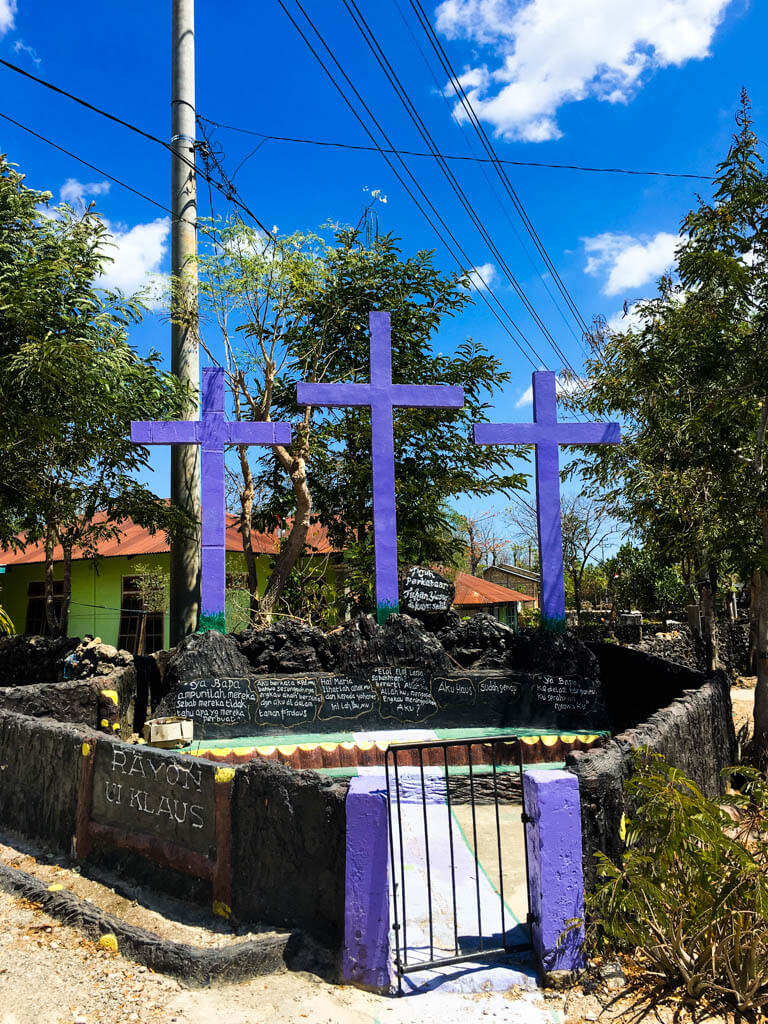
Christian crosses dot the countryside in rural West Timor
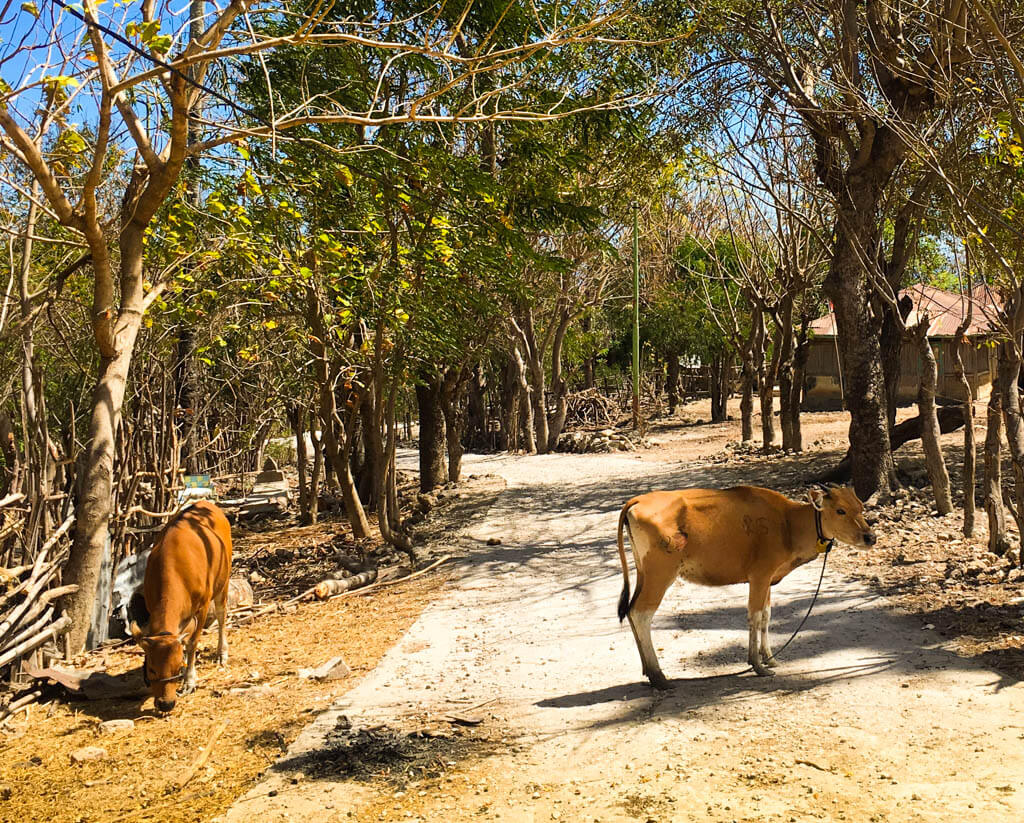
Watch out for the cows!
We paid 5k rupiah (€0.32/$0.35) each for parking at the entrance to Tablolong beach and, when we arrived at the shore, we were blown away by the beauty of the almost-deserted sandy beach. A few boats lay moored in the calm waters, adding an extra dimension to the scene and making it even more picturesque. Later, looking at a map, we realised that the water there is actually part of the strait between Timor and Semau island, a few kilometers off the coast, which is why it was so calm.
The beach was deserted, apart from a few locals sitting around drinking tea and a group of children playing in the shallows. We chatted briefly with the locals, who gave us some instant coffee, changed into our swimwear and went for a dip. The water was pleasant, although a little cloudy, and the bottom had a muddy texture, rather than being sandy like the beach, but under the hot sun, the cool water felt amazing. It was not polluted as far as we could tell, which makes a nice change from some other areas of Indonesia, such as Sunda Kelapa harbour in Jakarta.
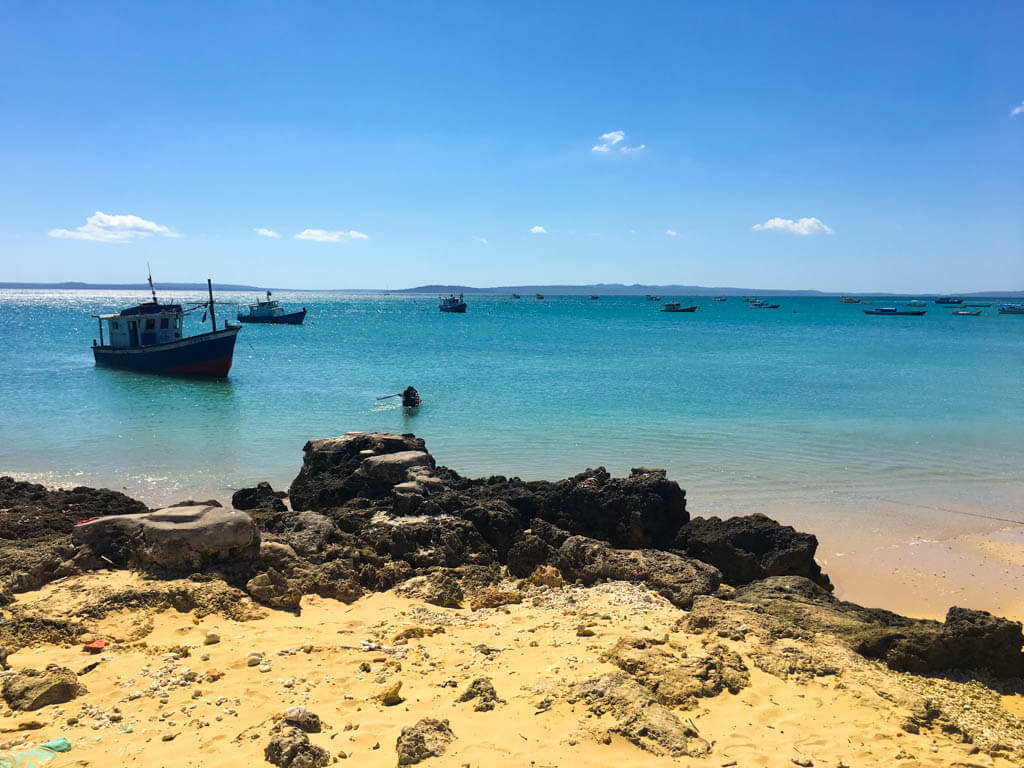
Ships moored by the Tablolong beach

We almost had the beech to ourselves (and no crocodiles here either!).
While we were swimming, three half-Timorese half-Australian girls appeared and started taking selfies by the beach. We chatted with them for a little while before getting back on our bikes and going on to find some food. They were the only other (half) foreigners we saw all day.
A few minutes further along the track by the beach, we came across a dilapidated-looking area that had once been a scenic resort. There were little wooden shelters with places to sit and watch the sea, wooden huts with thatched roofs to eat in and a couple of little shops. Actually, during the day we came across several places that looked like they had been designed for large numbers of tourists, who somehow never came, and had fallen into disrepair. By this point we were ravenous and happily accepted one local’s offer to cook us some fish freshly caught from the sea by a local fisherman. First we haggled for the fish, which seemed unusually expensive, then, after agreeing a price, he tried to add 50k rupiah for cooking it and 6k each for rice! We bargained to a more reasonable 30k for cooking and finally his wife got underway preparing it. It was delicious! Worth all the bargaining and hassle hands down, and for four large fresh fish, the 70k rupiah we paid was actually pretty good.
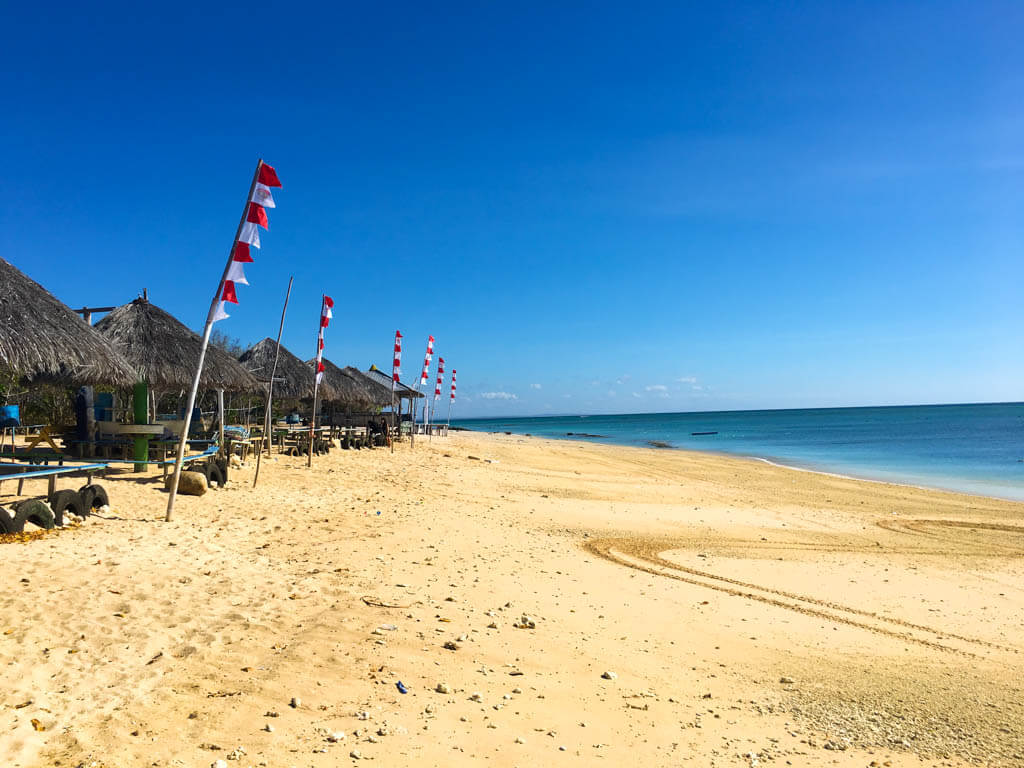
The resort may have a rundown feel, but the beach huts still provide welcome shade.
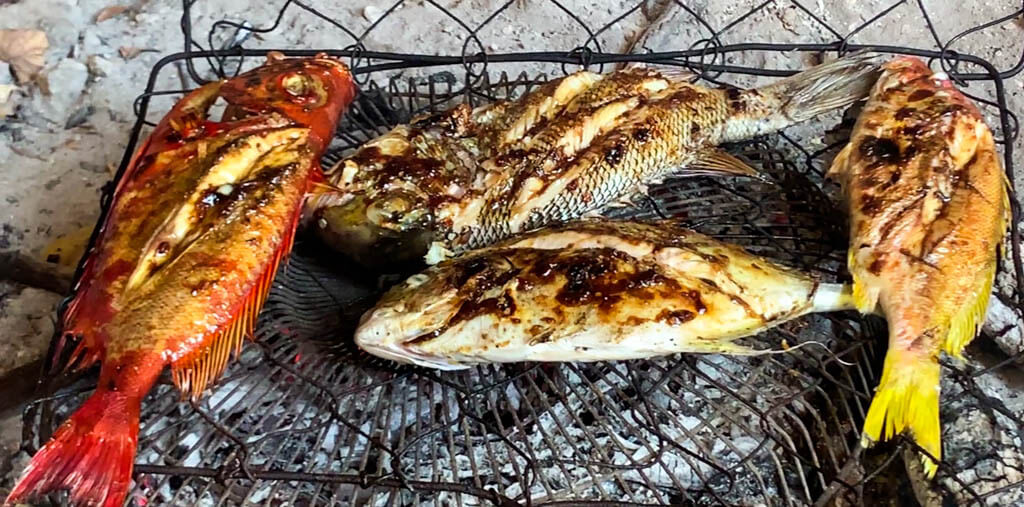
Freshly cooked fish straight from the sea. It doesn’t get better than this!
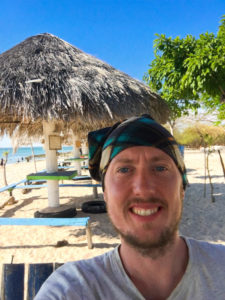
Say cheese!
When we were ready to leave, someone we had not seen before suddenly turned up (as they do) and asked us for money for the parking! I told them we’d already paid for parking at the entrance and he said that this was different parking! I wouldn’t have paid it – we were giving business to their restaurant anyway – but Tim was more flexible than me and paid up.
On our way back to Kupang, we stopped at the Oenesu waterfall, which is conveniently situated just off the main road. Like the seaside resort, the area looked like it had been built for a large influx of tourists that never came. But stranger still, despite there being no tourists and many of the facilities looking derelict, workmen were busy expanding it by building new facilities. We walked down the steps from the car park to the waterfall. It’s a short walk and the waterfall is quite impressive, even during the dry season when the waters are not so high. I read online that it’s possible to swim there during the dry season (dangerous during the wet season), but the water didn’t look that clean, especially after the beautiful clear waters of the Crystal Cave, so we skipped.
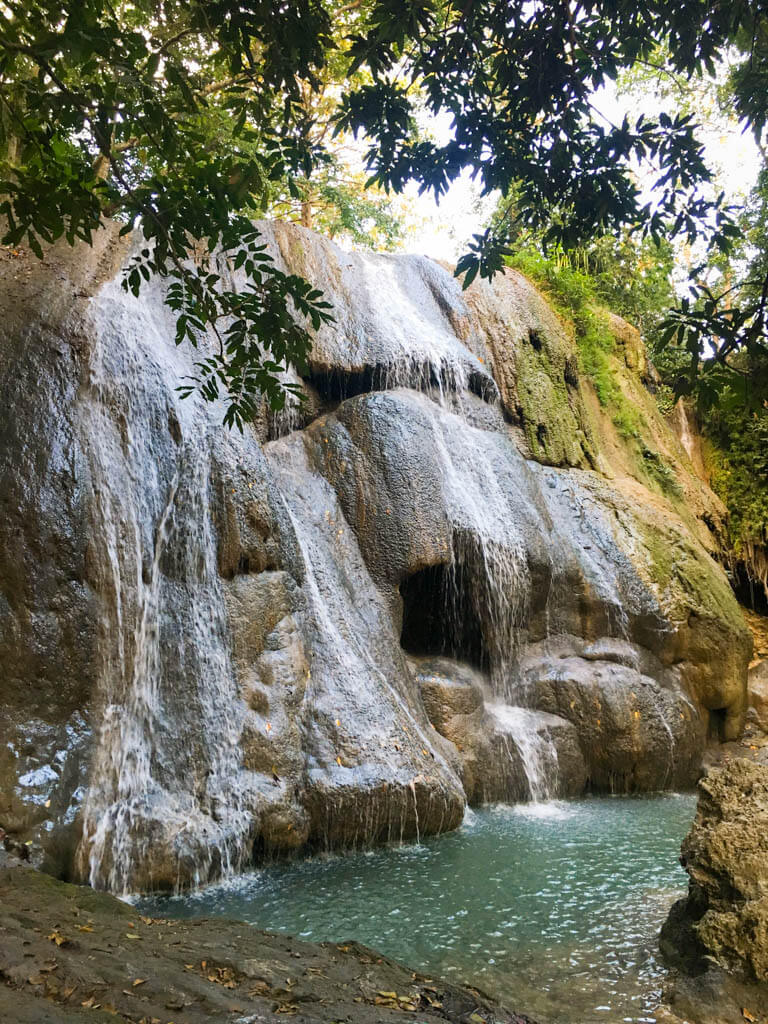
Oenesu waterfall. Worth a quick look on the way back from Tablolong beach.
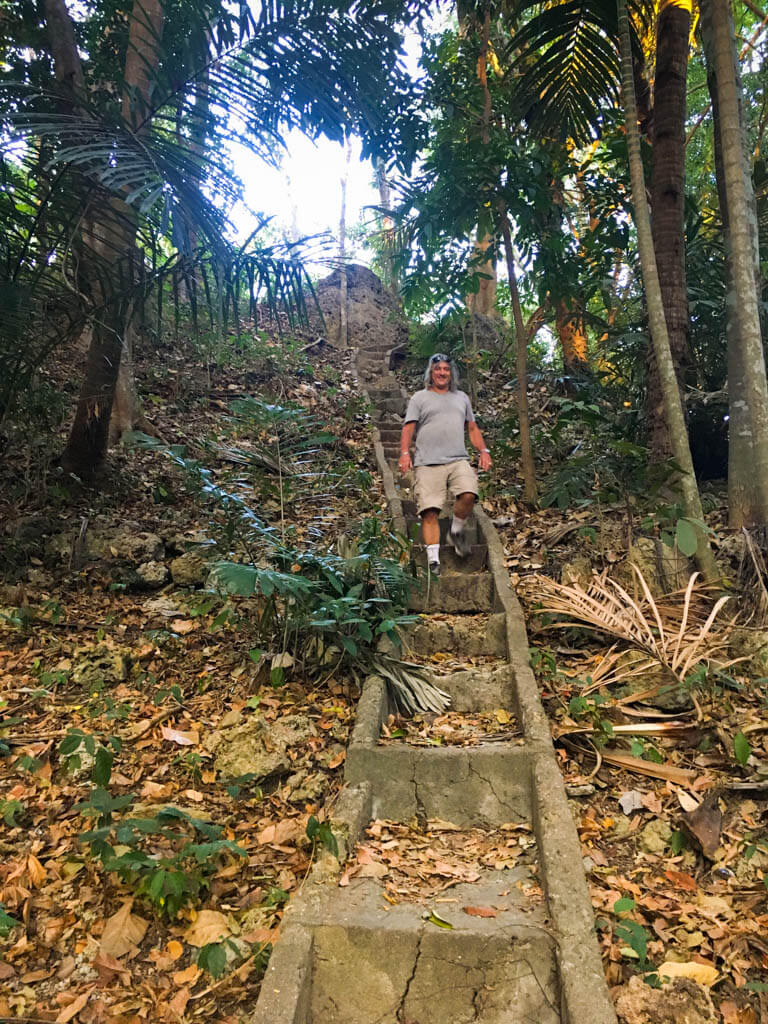
Tim climbing some stairs though the jungle at Oenesu waterfall.
Back in Kupang
I spent far longer in Timor that I originally expected, a month instead of 2-3 weeks, but there were still many other places I could have visited. One place I was sad not to spend more time in was Kupang, the provincial capital. The city is small by Indonesian standards, with 350,000 inhabitants, and has a developing city feel, which is to say it’s a hive of activity and quite chaotic. It has everything though, with local markets, little shops and street vendors, the major convenience store chains and was also the only place in Timor where we found a modern shopping center and giant Carrefour. The Carrefour in particular is a handy place to stock up on things that can be more difficult to find or expensive, such as sunblock.
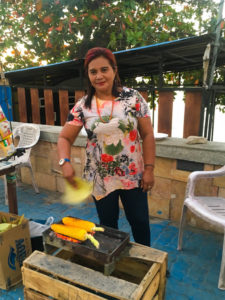
A lady sells delicious corn by the side of the road by the Kupang waterfront
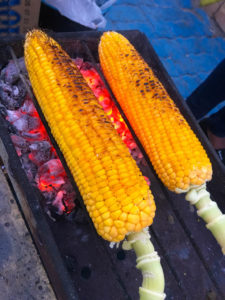
Barbecued corn Kupang style (I.e., with chilli sauce).
As Timor is Christian, unlike in the Muslim-majority parts of Indonesia, eating pork is considered normal, if expensive by local standards. Kupang is famous for Se’i Babi, a type of smoked pork that Tim and I are completely divided over – I would rate it as one of the best things I’ve ever eaten in my life, and Tim reckons it’s a bit meh. Try it and make up your own mind. It’s dripping in oil and feels like you’ve eaten a brick half an hour later, but the taste is even better than bacon. We shared a portion one evening before heading to 999 bar for a couple of cold beers. I liked it so much that I went back again alone for another round when I came back through Kupang three weeks three weeks later.
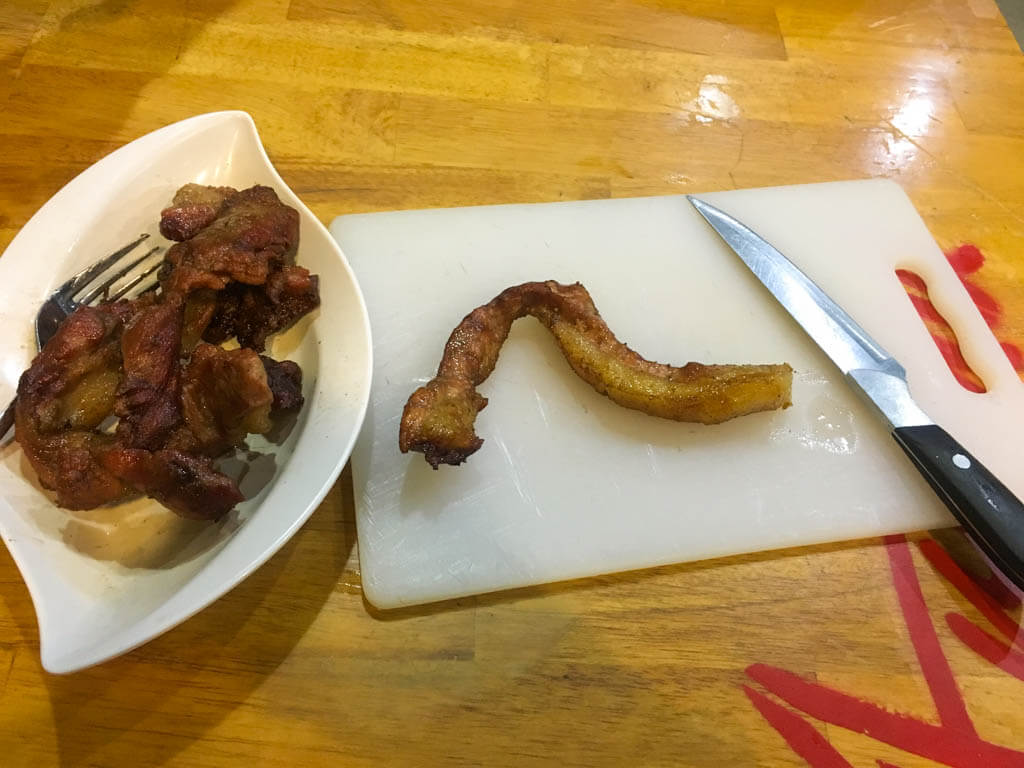
Not much to look at, but possibly the world’s tastiest pork.
Kupang has a lot to offer in terms of street food too. There’s a cute little night market with barbequed fish and other delicacies just ten minutes walk from the hostel, street sellers throughout the city, and a large number of boutique restaurants. Whether you’re looking for a sit-down meal or a cup of bubble tea, the chances are you’ll find it in Kupang. Or even this gloopy thing that I bought from a random roadside vendor for 10k one afternoon, sweet with a delicious burnt caramel taste. If the city was a little more convenient to reach, I’d actually like to go back for a few days just to hang out and try the local delicacies.
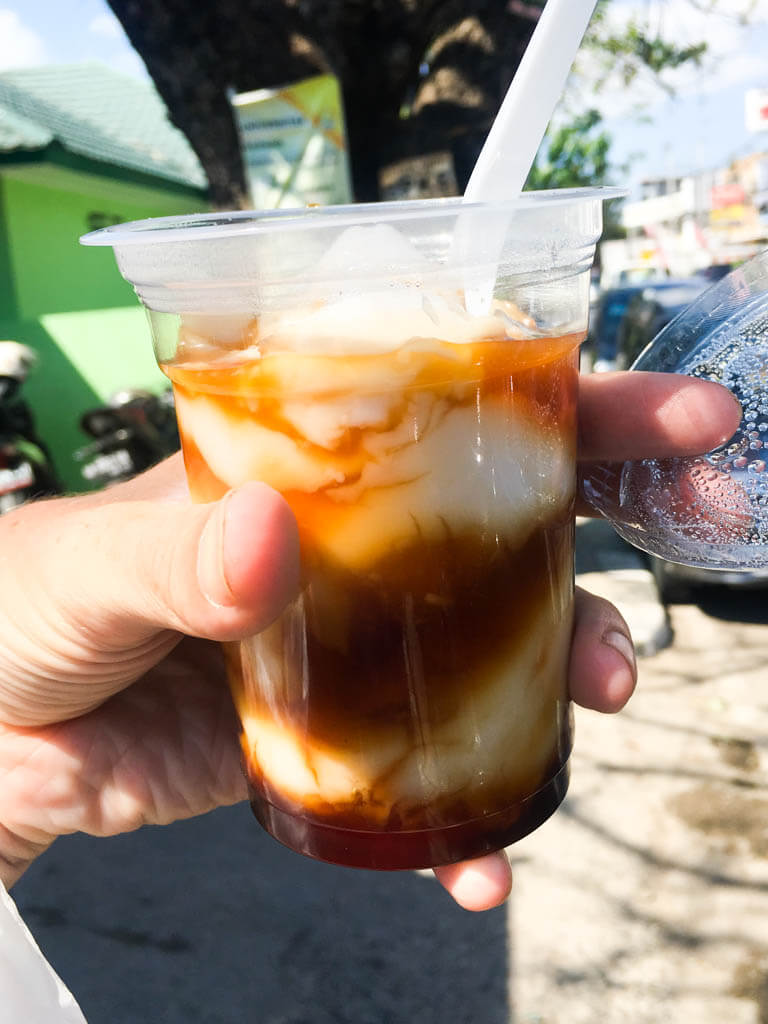
A cup of gloopy deliciousness from the streets of Kupang
More Stories from Indonesia
This article is the first in a series of three articles I’m writing about my adventures in West Timor. If you enjoyed it and want to know more, check out the others here:
West Timor: Crystal Pools and the Best Pork in the World
West Timor: The Terrifying Ascent of Mt. Fatuleu
West Timor: A Night in Tamkesi Traditional Village
Indonesia’s capital isn’t all glitz and flashy new buildings. If you want to explore the gritty industrial side of Indonesia’s largest megacity (and see how I risked being eaten by guard dogs and almost impaled myself on a vicious looking nail), check out my my aricle on Sunda Kelapa harbour:
Sunda Kelapa Harbour: Exploring the Old Port of Industrial Jakarta
I also spent almost two weeks Couchsurfing in the Jayapura region of the fairy tale land of West Papua:
West Papua: The Lake Where Dreams Come True
Useful Tips
- To get from the airport to the city centre or hostel by public transport, leave the airport car park through the main gate and turn left. Walk for about one kilometer and you will reach a roundabout. Turn right at the roundabout and wait by the side of the road until a bemo (minivan) comes along. Just stick your arm out to flag it down and tell the driver Kupang. Our bemo went within about half a kilometer of Lavalon hostel, at which point we should at the driver to stop and got out and walked, but I’m not sure whether this was simply luck or whether all of them take this route. The cost is fixed at 3k rupiah (€0.19/$0.21) per person, so refuse if the driver asks for more than this.
- Bike hire in Kupang is twice the price of Bali – we paid 100k rupiah (€6.44/$7.04) each per day from Edwin at Lavalon Hostel. The bikes are automatics and, while not the best, were a lot better than some of the others we had on this trip.
- If Lavalon Hostel cannot get bikes (which happens), Sewa Motor can provide them for 90k rupiah (€5.79/$6.33) a day. The reason I don’t recommend them over Lavalon, despite the lower price, is that they’re located quite far from the seafront area where most of the hotels are, so it’s a hassle to get there. Also, the location on Google Maps is not accurate. Their contact number is +6281334879121 and you can message them on WhatsApp to check availability and the correct location. They were very friendly and helpful, even after I told them that I’d managed to obtain the bikes from Lavalon Hostel and wouldn’t be renting from them after all.
- In rural parts of West Timor, there are few petrol (gas) stations, However, you will see many people with bottles of yellow liquid on the edge of the road, which is petrol for the bikes. It’s slightly more expensive than the big Pertamina petrol stations, but still only about 8k rupiah (€0.51/$0.56) a litre and many times there are no other options. In Indonesian, petrol (gasoline) is known as bensine.
- Lavalon Hostel is the only hostel we found in Kupang and Edwin, the owner, is very knowledgeable about the local area. The hostel is also quite sociable when there are many people staying. It’s not on HostelWorld or Booking.com, but you can find it on Tripadvisor and the location is on Maps.Me. Dormitory beds are 70k rupiah (€4.51/$4.93) a night, including a basic breakfast.
- Don’t visit the crystal cave before about 11am. The cave entrance is quite narrow and before this time the sunlight doesn’t really penetrate, so the water appears dark and not particularly pleasant.
- Some of the roads in West Timor are pretty rough, so it’s good to gain experience on a bike somewhere easier first (e.g., Laos or Thailand). Take it slowly and beware of loose gravel, as it’s easy to lose your grip, especially as the tyres on many rental bikes are quite worn. Google Maps generally has good maps of even the smaller roads (just avoid the route it gives from Kupang to Mt. Fatuleu), so don’t be afraid to take some of the smaller tracks. It’s fun and you’ll see lots of interesting sights you’d have missed otherwise, plus plenty of surprised locals wondering what on earth you’re doing so far off the beaten tourist path.
- To get to the resort area at Tablolong beach, after entering the beach area, continue driving along the rough track past the obvious turn off to the beach. After about 5-10 minutes you’ll see some little beach huts on your right, overlooking the sea, and a couple of shacks that double as shops. Although Tim spoke to them in Indonesian, the people there did speak a bit of English, and it was by asking them about food that we found out about the fresh fish. Whether it’s available depends on the time of day and what time the fishing boats return. We paid 70k rupiah (€4.53/$4.95) for four fish (a good size meal for two), 30k rupiah (€1.94/$2.11) for cooking and 12k (€0.78/$0.85) for the two portions of rice. Plus, when we left, 5k (€0.32/$0.35) per motorbike for parking. The people were friendly enough, but it was one of those places where I felt like they saw us more as walking dollar signs than actual people.
- The roads from Kupang to the Crystal cave, Tablolong beach, Oenesu waterfall and Mt. Fatuleu are all pretty good, even if you have to ride along them at night. Just make sure that you check the lights on the bikes when you rent them. We had several issues in this region with bike lights that didn’t work.
- Kupang is not an expensive city and a meal of se’i babi smoked pork for two, with rice and a vegetable side dish, cost 120k rupiah (€7.72/$8.45). I recommend Depot Se’i Babi Aroma, which is about half an hour’s walk from Lavalon hostel and the waterfront.

Recent Comments